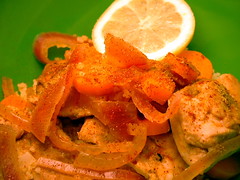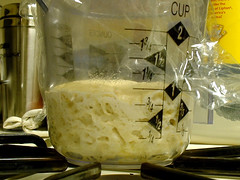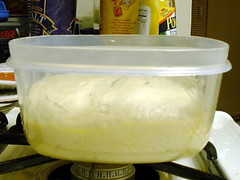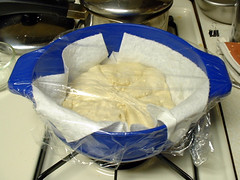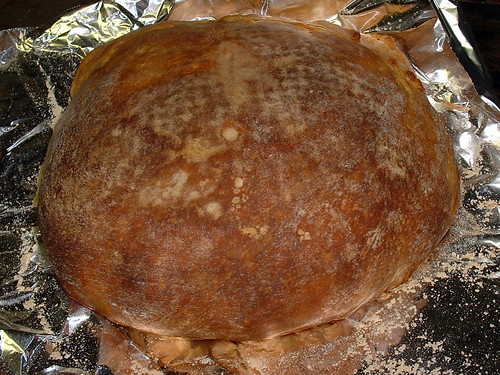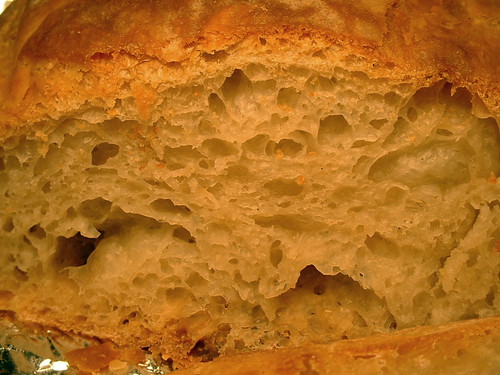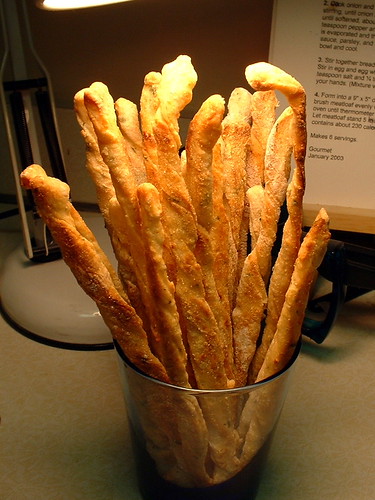
There's a bit of a chill in the air today. After an incredibly hot summer, this is good news... but it's even better news for those of us who enjoy baking. Now, I like cooking and putting together meals, certainly. However, my true kitchen love is baking, especially bread baking. Cakes and cookies are all well and good, but there's something about getting my hands into a ball of dough that I find incredibly satisfying. No, no stand mixer here, just me and my skinny arms. :)
First off, anticipating the cooler weather that's coming, I got out my sourdough starter and fed it. It seems to have made it through the summer hibernation just fine, so there will definitely be some sourdough products making an appearance. The process for making sourdough breads isn't much different than the one for making cultivated yeast breads... it just takes much, much longer. They're worth it, though.
I also needed some baking instant gratification, so I made a batch of grissini (thin, crunchy breadsticks). I flavor mine with parmesan cheese, garlic powder, and cayenne pepper. They come out crispy, perfect for snacking. Personally, I like the kick from the cayenne pepper, but it can certainly be left out.
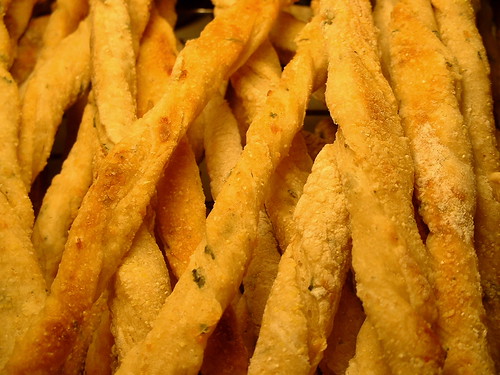 Grissini
GrissiniMakes about 50 breadsticks
1/2 teaspoon instant yeast
1/2 teaspoon sugar
1/4 cup warm water (about 100 degrees)
2 cups bread flour
1/4 cup whole wheat flour
1 teaspoon salt
1 teaspoon black pepper
1/2 teaspoon garlic powder
1/2 cup grated Parmesan cheese
1 tablespoon minced herbs (basil, parsley, rosemary, thyme, and/or sage would work nicely)
1/4 teaspoon cayenne pepper (optional)
3/4 cup warm water (about 100 degrees)
Cornmeal for dusting
Bloom the yeast: Combine the yeast, sugar, and 1/4 cup warm water in a small bowl. Allow to sit for 5-10 minutes. If your yeast is alive and kicking, a foamy layer will develop. If this doesn't happen, try again.
Mix and knead the dough: Meanwhile, combine the bread flour, whole wheat flour, salt, pepper, garlic powder, Parmesan cheese, minced herbs, and cayenne pepper in a large mixing bowl. Whisk to evenly distribute the ingredients. Add the yeast mixture and 3/4 cup warm water to the flour mixture. Stir until the dough comes together and begins to pull away from the sides of the bowl. Turn the dough out on to a floured surface and knead lightly until it is smooth and elastic, about 5 minutes.
Allow the dough to rise: Lightly coat the inside of a large bowl (1-qt or larger) with olive oil. Transfer the dough to the bowl, turning to coat with oil. Push the dough down to create a flat surface, and make note of where double the current dough height is with a rubber band or piece of tape. Cover the bowl with a lid or plastic wrap, and allow to rise at room temperature for one hour. Gently deflate the dough, then re-cover and allow to rise for another hour. Deflate the dough again, and let it rise for one hour or until doubled the initial volume.
Prepare the oven and baking sheet(s): Preheat the oven to 375 degrees. Position an oven rack on the second slot up from the bottom. Line a baking sheet with parchment paper.
Shape the dough and bake: Lightly dust your work surface with cornmeal. Cut the dough into quarters. While working with one piece of dough, cover and refrigerate the other pieces. Form one dough quarter into a ball and flatten it gently. Dust the top with more cornmeal. Roll out the dough to 1/8" thick, and then cut into 1/2" wide ribbons with a knife or pizza cutter. Give each ribbon a few twists before setting on the baking sheet. Brush each breadstick with olive oil and sprinkle lightly with cornmeal. Bake for 14-18 minutes or until golden. Repeat with remaining dough. If you have multiple baking sheets, you can, of course, work with two or more dough batches at once.
Finishing: Allow the breadsticks to cool. They will still be slightly soft and chewy at this stage, and you can leave them this way if desired. If you want them completely crunchy, return them to the oven at the lowest possible temperature setting (pilot light, if you have that option) for about an hour or until totally crisp.
Technorati tags:
baking,
breadsticks,
recipes,
yeast breads
